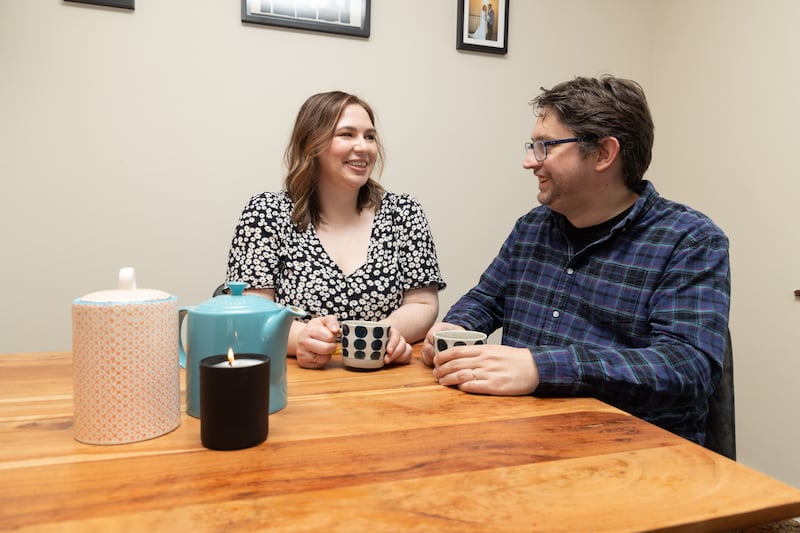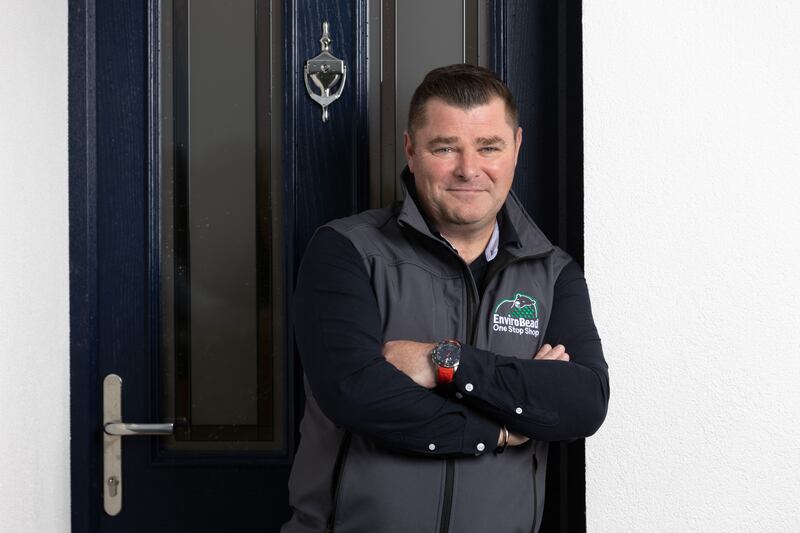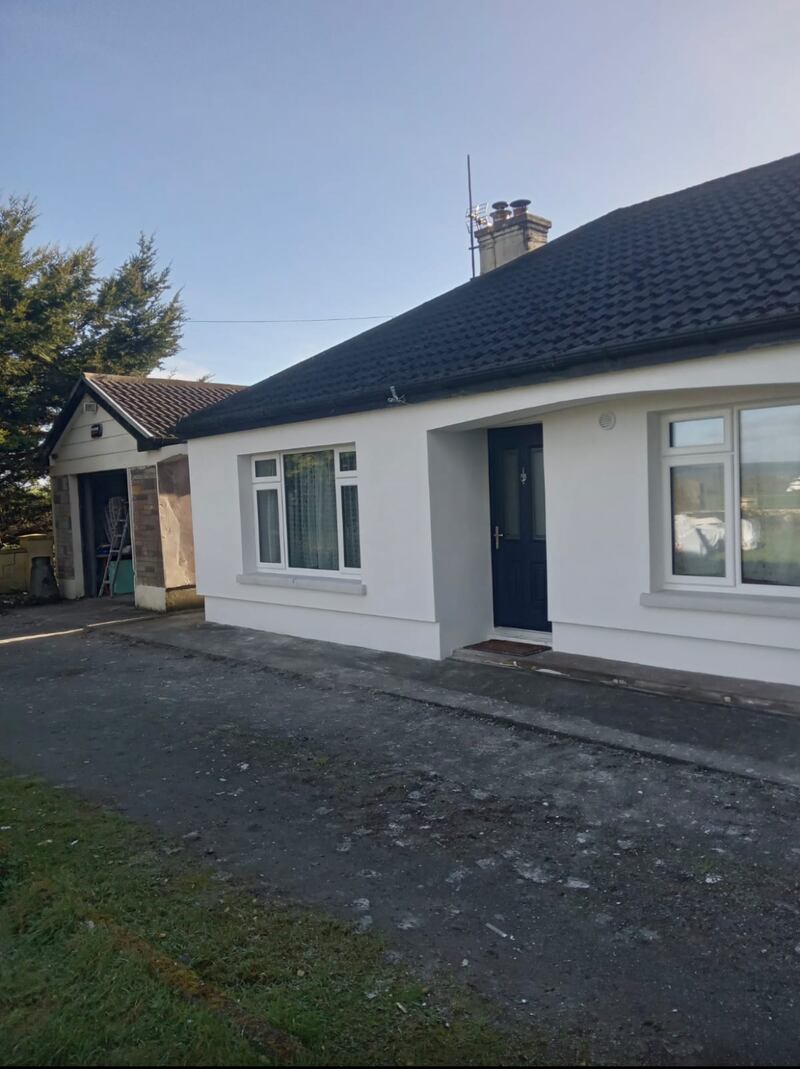Your home should feel warm and cosy. When Honora Kelleher moved into hers, it was anything but.
“It had a Ber rating of F,” she says. F for freezing.
She and her then boyfriend Mike Hennessy had lived in Dublin for a decade, working in financial services. When the pandemic came, they moved back to Cork, staying with their respective families.
Within a year they had saved enough for a down payment and opted to buy Mike’s grandparents’ former home, a three-bedroomed, detached bungalow in Mourneabbey, a rural parish in north Co. Cork.
“We both wanted to live in the countryside, so a new-build was never an option for us,” she explains.
While the house was perfect in many ways, it was also “absolutely freezing”, she says. “It was built around 1980 and nothing was done with it since.”
They spent the first 12 months after purchasing it saving hard to get married, which they did last year. “We got engaged in the house too, so it already holds so much history for us,” she says.

Cold comfort
It was only when Honora’s elderly father came to live with them that his comfort, and theirs as a couple working from home, saw warmth become a top priority.
“It had double glazing but with huge gaps, so draughts were coming in. It had absolutely no insulation. We went through three tanks of heating oil a year and had to have the radiators on 16 hours a day. As soon as you turned them off the heat went out through the walls and you were freezing again,” she recalls with a shiver.
“Every morning there was a bite to the air. We were having hot showers just to heat up. We spent our time wrapping ourselves up and the fire was on constantly.”
The experience led her to the website of Sustainable Energy Authority of Ireland (SEAI). “I knew we needed to upgrade the house and I wanted to find out about the available grants,” she says.

One Stop Shop scheme
Through the SEAI site Hanora discovered its One Stop Shops. Launched last year, this is a scheme that connects homeowners with energy efficiency experts who will project manage entire home energy upgrades from start to finish.
“We work in financial services. We don’t know about home heating or construction. We wanted someone to come in, do everything we needed, and leave us with a warm home,” she explains.
That’s exactly what happened. Her local One Stop Shop was specialist firm Envirobead, based in nearby Mallow.
“They talked us through all the energy solutions we would need to take the house from an F to an A3 rating, and what the works entailed,” she says.
Envirobead pumped the walls with insulation as well as externally insulating them, replaced the windows and doors, installed a new heat pump and radiators, introduced a mechanical ventilation system to better manage the indoor air quality and installed solar panels on the roof to help reduce electricity consumption.
The results the couple say are fabulous – ones they can physically feel.

Consistent warmth
“The heat pump keeps the temperature consistently perfect. You don’t have to think about it. We used to have damp on a gable end of the house and condensation on the windows, and that’s all gone now too,” she explains.
The external insulation is her favourite. “Being an ‘80s house we had interesting-looking brick work. To change it we’d have had to get planning permission but not to insulate. Now the house is white with a lovely smooth finish, with smart new windows and doors.”
The couple plans to renovate the rest of the house too. “We have crazy 1980s carpets”, she says that she’d like to change. But they can wait. In terms of creature comforts, it’s already perfect.
The total cost, net of the grants available, they spent was €53,000. The Kellehers were able to avail of a lower interest-rated green loan because the A-rating they achieved with their upgrades exceeded the B2 threshold set by most banks. They didn’t even have to move out while the works were carried out but chose to stay with family for three days while the radiators were being replaced.
“The One Stop Shop team made sure all the contractors came at the same time, so most of the work was done within two weeks. I’m so glad we got it all done together. If we’d done it piecemeal it would have taken forever,” she explains.
“It’s just been so worth it. It’s like a different house. It’s so comfortable that we walk around in t-shirts all the time now, in a property that used to be cold even in summer because the living areas all face north.”
Thanks to the combination of upgrades, their energy consumption has been reduced by 80%, she no longer has to buy heating oil or keep the heating on all the time to keep the temperature comfortable in her home. She no longer ever wakes up freezing cold.

Single point of contact
Honora dealt with Fergal Cantwell, Envirobead’s One Stop Shop manager, throughout the entire process.
“The application forms are simple and SEAI has a portal which means One Stop Shop contractors can get approval for their customers in minutes. The benefit to customers is that the grants are discounted upfront, the client gets the money immediately and the retrofit work has to pass an SEAI inspection for us to get our payment, which gives great comfort to the homeowner too,” says Cantwell.
The cost of works to bring an average detached home from an E1 to an A2 rating, €64,506, according to SEAI estimates. Of that grants account for €24,098 of the outlay, so the net cost to the homeowner is €40,408. There is a more comprehensive outline of the various costs homeowners can expect to pay here.
Cantwell knows what he’s talking about having completed an energy upgrade on his own home in 2019. “The difference is phenomenal. Weather-wise you never know if you’re need a jacket or not till you open the front door,” he says.
That tallies with SEAI feedback from home energy upgrade clients which finds the number one reason people are happy with the work is the increased levels of comfort they feel at home. Comfort scores even higher than energy savings, which can be significant.

SEAI supporting you
Previous feedback taught the SEAI that some homeowners were being put off by the complexity of home energy upgrades, especially having to deal with and manage the timings of a variety of contractors.
“It’s why the One Stop Shop manages the entire process from end to end, from initial assessment to selecting contractors, to administering grants, project managing and quality assuring,” says Stephen Farrell, One Stop Shop programme manager at SEAI.
“We have simplified it for the homeowner and given all that responsibility over to the experts.”
There are currently 17 registered One Stop Shops operating in Ireland, a figure set to rise as demand grows.
Homeowners are advised to get quotations from three different One Stop Shops, just as they would if doing any home improvements from adding a new bathroom to extending the footprint or building a new house from scratch.
“There are individual energy upgrade grants available too for those who do not have the funding to do the whole house, or for whom that is not a priority right now” he points out.
“But if you go the major upgrade route, it’s about increasing the level of comfort in your home, doing your bit for the environment and increasing the value of your home.” he says
To find out more visit seai.ie














